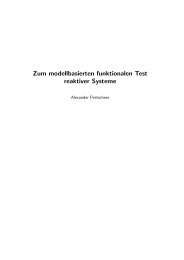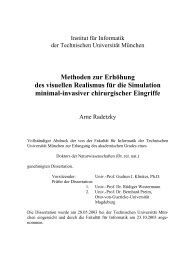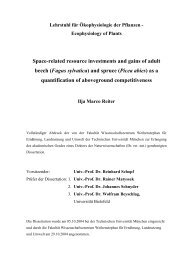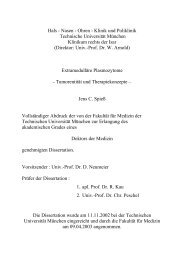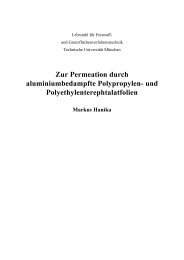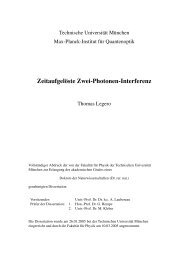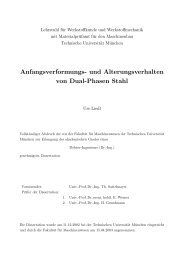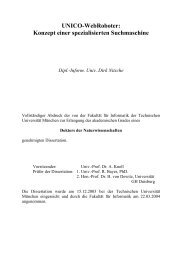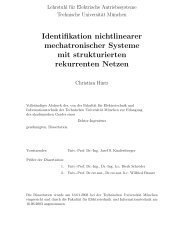Topologically Defined Neuronal Networks Controlled by Silicon Chips
Topologically Defined Neuronal Networks Controlled by Silicon Chips
Topologically Defined Neuronal Networks Controlled by Silicon Chips
You also want an ePaper? Increase the reach of your titles
YUMPU automatically turns print PDFs into web optimized ePapers that Google loves.
CHAPTER 2. NETWORKS OF DEFINED TOPOGRAPHY<br />
naptic spikes were only fired in neuron 1 upon presynaptic stimulation of 2. Neuron 2 was depolarized<br />
only a little when it was postsynaptic and remained quiescent.<br />
To localize the synapse in the network depicted in the bottom row of fig. 2.21, it was stained with<br />
Lucifer Yellow, first cell 1, see left micrograph, then cell 2, as shown in the right micrograph. Most<br />
neurites nicely followed the grooves, only a small one left the structure at the pit of neuron 1. Compared<br />
to example 2.19, the position of the synapse was much less defined here. The neurite from cell 2 grew<br />
in parallel to that of neuron 1. Note the white ‘dots’ in the left side groove in the left micrograph indicating<br />
the presence of a rather thin neurite originating from 1. The synapse must be somewhere along<br />
the line of fasciculated growth of both neurites marked in the right micrograph, but its exact location is<br />
unknown.<br />
Electrophysiological recordings revealed a very strong connection, the averaged coupling coefficients<br />
were k1,2=0.69 and k2,1=0.51. Most presynaptic APs in neuron 1 also triggered spikes in cell 2. Changing<br />
the direction of signal transfer resulted in even stronger postsynaptic activity, with every spike in 2<br />
triggering a spike in cell 1.<br />
Given the examples above, one might conclude that the strength of synaptic coupling is the only parameter<br />
governing the generation of postsynaptic action potentials, with a larger coupling coefficient<br />
increasing the probability for a spike being triggered. However, the resting membrane potential of the<br />
postsynaptic neuron plays an important role, as well. If it is very high, near the firing threshold, just a<br />
small increase of the membrane potential is sufficient to trigger an AP. In this case, even a weak synaptic<br />
coupling is sufficient. But if the resting potential is rather low, a large postsynaptic depolarization<br />
resulting from a strong synapse may still not be sufficient to raise the cell above its firing threshold.<br />
Therefore, two parameters have to be taken into account when discussing the triggering of postsynaptic<br />
action potentials, the coupling coefficient and the respective resting potential.<br />
2.5.4 Characterization of synapses<br />
Of 84 networks grown on SU-8 structures in this assay, 51 were synaptically connected, but only 26<br />
were evaluated in detail. The others had ambiguous connection patterns that made the assignment<br />
of coupling to an identified synapse impossible, e.g. three neurons with unknown signaling path. Fig.<br />
2.22A shows a histogram of coupling coefficients for the 26 pairs. Two values are included per pair, one<br />
for each direction of signal transfer k1,2 and k2,1. The numbers are averaged from several recordings<br />
with currents of different amplitude injected in the cell pair. Most values range between 0.1 and 0.6,<br />
with extrema of 0.01 and 0.78. In general, they are higher than the coupling coefficients in networks on<br />
UV-patterned substrates [79] and the example net depicted in fig. 2.20. Still, they are well within the<br />
range found with the mollusks Helisoma and Aplysia on plain, unpatterned substrates [7, 41].<br />
Although the coupling coefficient is an ideal quantity for describing the effects of the presynaptic input<br />
on a postsynaptic neuron, it conveys only limited information about the synapse itself. As shown <strong>by</strong><br />
eq. 2.24, kpre,post is not only determined <strong>by</strong> synaptic properties but also <strong>by</strong> the soma conductance<br />
of the postsynaptic neuron. The synaptic conductance Gsyn is the quantity that entirely characterizes<br />
electrical synapses. It is determined from electrophysiological recordings <strong>by</strong> the following procedure:<br />
36<br />
– First, VA,0 and VB,0 are obtained from recording the membrane potentials of both neurons, A and<br />
B, before current injection.<br />
– Then, a constant hyperpolarizing current Iinj,∞ is injected in neuron A and the stationary presynaptic<br />
and postsynaptic response is measured after initial transients have decayed, VA,∞ and VB,∞.<br />
GA, GB and V0B are calculated from 2.26, 2.27 and 2.28.<br />
– The steps above are repeated to determine V0A, but this time with B as the presynaptic neuron where


